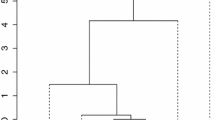Abstract
The dominant feature distinguishing one method of principal components analysis from another is the manner in which the original data are transformed prior to the other computations. The only other distinguishing feature of any importance is whether the eigenvectors of the inner product-moment of the transformed data matrix are taken directly as the Q-mode scores or scaled by the square roots of their associated eigenvalues and called the R-mode loadings. If the eigenvectors are extracted from the product-moment correlation matrix, the variables, in effect, were transformed by column standardization (zero means and unit variances), and the sum of the p-largest eigenvalues divided by the sum of all the eigenvalues indicates the degree to which a model containing pcomponents will account for the total variance in the original data. However, if the data were transformed in any manner other than column standardization, the eigenvalues cannot be used in this manner, but can only be used to determine the degree to which the model will account for the transformed data. Regardless of the type of principal components analysis that is performed—even whether it is Ror Q-mode—the goodness-of-fit of the model to the original data is given better by the eigenvalues of the correlation matrix than by those of the matrix that was actually factored.
Similar content being viewed by others
References
Chayes, F., 1960, On correlation between variables of constant sum: Jour. Geophys. Res., v. 65, no. 12, p. 4185–4193.
Imbrie, J., 1963, Factor and vector analysis programs for analyzing geologic data: U.S. Department of Commerce, Office of Naval Research, Geography Branch, ONR Task No. 389-135, Contract Nonr. 1228(26), Tech. Rept. 6, 83 p.
Jöreskog, K. G., Klovan, J. E., and Reyment, R. A., 1976, Geological factor analysis,in Methods in Geomathematics, v. 1: Elsevier Scientific Publishing Co., 178 p.
Klovan, J. E. and Imbrie, J., 1971, An algorithm and FORTRAN-IV program for large-scaleQ-mode factor analysis and calculation of factor scores: Jour. Internat. Assoc. Math. Geol., v. 3, no. 1, p. 61–77.
Miesch, A. T., 1976,Q-mode factor analysis of geochemical and petrologic data matrices with constant row-sums: U.S. Geol. Survey Prof. Paper 574-G, 47 p.
Miesch, A. T., 1979, Vector analysis of chemical variation in the lavas of Parícutin volcano, Mexico: Jour. Internat. Assoc. Math. Geol., v. 11, no. 4, p. 345–371.
Miesch, A. T., in press, Computer methods for geochemical and petrologic mixing problems,in Computer applications in the earth sciences—an update of the 70's, D. F. Merriam (ed.): Plenum Press, New York.
Miesch, A. T. and Reed, B. L., 1979, Compositional structures in two batholiths of circum-Pacific North America: U.S. Geol. Survey Prof. Paper 574-H, 31 p.
Rummel, R. J., 1970, Applied factor analysis: Northwestern Univ. Press, Evanston, Ill., 617 p.
Trochimczyk, J. and Chayes, F., 1978, Some properties of principal component scores: Math. Geol., v. 10, no. 1, p. 43–52.
Wilcox, R. E., 1954, Petrology of Paricutin volcano, Mexico: U.S. Geol. Survey Bull. 965-C, p. 281–353.
Author information
Authors and Affiliations
Rights and permissions
About this article
Cite this article
Miesch, A.T. Scaling variables and interpretation of eigenvalues in principal component analysis of geologic data. Mathematical Geology 12, 523–538 (1980). https://doi.org/10.1007/BF01034742
Received:
Revised:
Issue Date:
DOI: https://doi.org/10.1007/BF01034742




